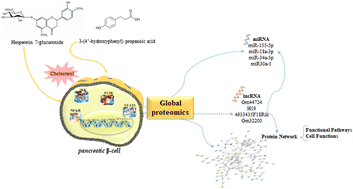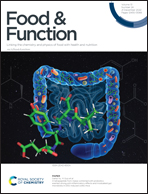Citrus flavanone metabolites protect pancreatic β-cells against cholesterol stress through a multi-proteomic mechanism†
Abstract
Citrus flavanones may improve oxidative stress and insulin resistance induced by western diets. However, there is a paucity of studies investigating the change in protein expression levels. This study evaluated the protection and the mechanisms of action of citrus flavanone metabolites, hesperetin 7-glucuronide (H7G) and 3-(4′-hydroxyphenyl) propanoic acid (PA), on pancreatic β-cell function under oxidative stress induced by cholesterol using the global proteomics approach. Cholesterol induced changes in the global proteomic profile in the pancreatic β-cell line Min6. On the other hand, proteomics analysis identified 254 proteins differentially expressed with H7G and 352 with PA treatments, most of them were opposite to the changes induced by cholesterol. Bioinformatics analysis showed that these proteins are implicated in cell functions like cell signaling (insulin signaling, p30MAPK signaling, and others), metabolism (glucokinase and glutathione metabolisms), and inflammation pathways (TNF-α and NF-κB pathways). Also, the results of molecular docking suggest that H7G and PA could bind to putative transcription factors (PPAR-γ, STAT-3, CREB1, NF-κB, NFYA) and cell signaling proteins (IKK, RAS, Pi3K, ERK), which results in changes in protein expression observed. Altogether, these data suggest that the treatment with H7G and PA protects pancreatic β-cells against stress induced by cholesterol through multi-proteomic mechanisms of action.



 Please wait while we load your content...
Please wait while we load your content...